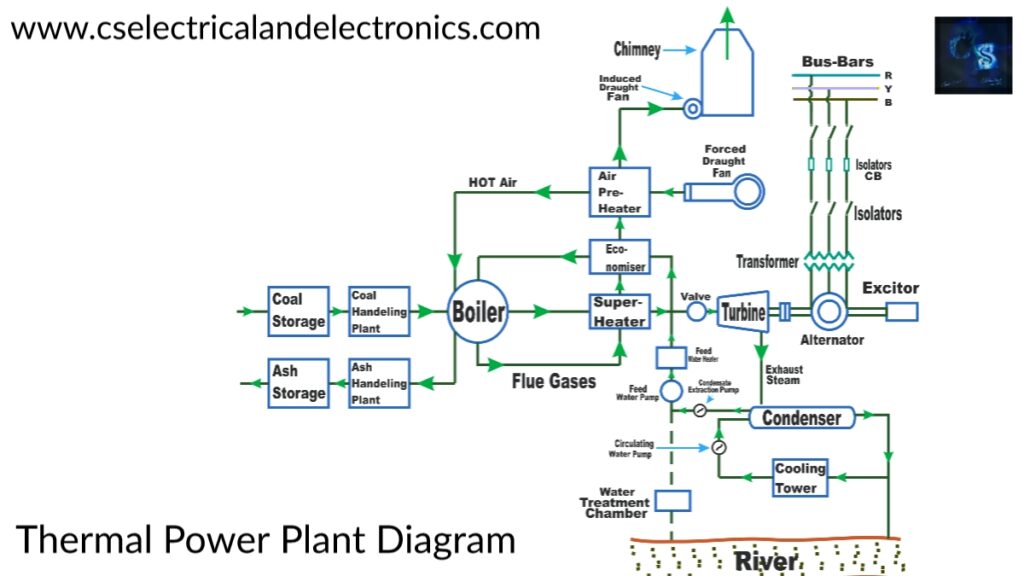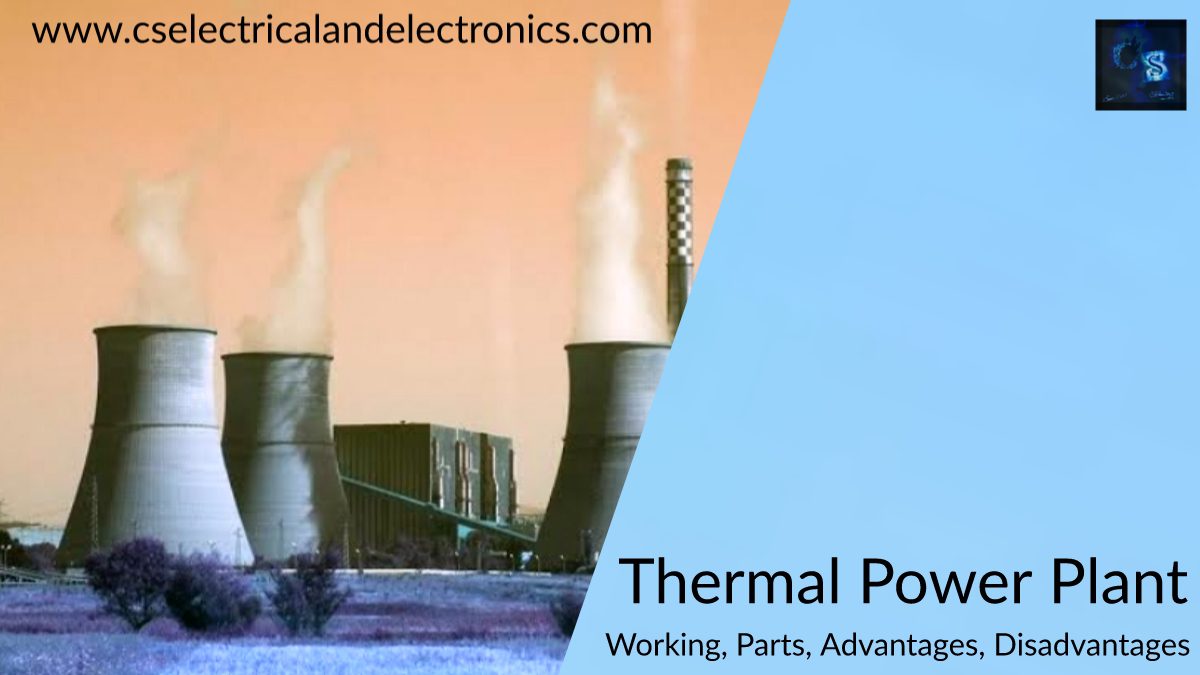Thermal Power Plant, Working, Parts, Advantages, DIsadvantages
Hello guys, welcome back to my blog. In this article, I will discuss the thermal power plant, working of the thermal power plant, parts of the thermal power plant, advantages of the thermal power_plant, and disadvantages of the thermal power plant.
If you have any doubts related to electrical, electronics, and computer science, then ask questions. You can also catch me on Instagram – CS Electrical & Electronics And Chetan Shidling.
Also, read:
- Difference Between Hydrogen And Lithium, Future Of Electric Vehicle
- What is Distance Relay, Working, Advantages, Disadvantages, Applications
- Overhead Line Components, Functions Of Components In Overhead Lines
Thermal Power Plant
- A power station in which heat energy of coal combustion is converted into electrical energy is known as a steam power station. It works on the Rankine cycle.
- Uses coal as a major component to generate electricity.
Selection Of Sites For Thermal Power Plant
01. Supply Of Fuel
The power station should locate near the coal mines to reduce transportation costs.
02. Availability Of Water
The huge amount of water is required for the condenser, that’s why these power stations must be located at the bank of a river.
03. Cost And Type Of Land
Steam power plant must be located at a place where land is of low cost and further extension, if necessary. The bearing capacity of the ground should be in such a way that it has to carry heavy equipment.
04. Labor supplies
Skilled and unskilled laborers must be available near the location of the plant.
05. Distance from a populated area
A large amount of coal will be burnt in this plant, it may lead to pollution of the surrounding area. So the area or cities must be located at some distance to live healthily.
Thermal Power Plant Working

This plant basically operates on the Rankine cycle. The schematic arrangement of a power station can be divided as follows.
01. Coal And Ash Handling Arrangement
The main source of steam power plant i.e. coal is supplied to the steam power plants by the help of rail and road, then that coal will be stored in the coal storage plant. But these coals will be big in size. To increase its surface exposure these coals must be cut into small pieces by using crushers. This pulverized coal is fed to the boilers with the help of belt conveyors. After complete combustion the ASH will be produced, then we have to remove the ash for the proper burning of coal. Then it will be delivered to the ash storage plant for disposal.
02. Steam Generation Plant
It consists of mainly 4 stages.
a. Boiler: In the boiler water will be converted to steam using the heat of combustion of coal. This steam will be having high temperatures and pressure. The fuel gases make journeys from a boiler to superheater, economizer, air-pre heater, finally exhausted to the atmosphere by the help of the chimney.
b. Superheater: The steam which will be produced in the boiler will be wet, to get dry steam et steam will be fed through superheater where it is dried and superheated by the fuel gases. This produces 2 benefits. One is the overall efficiency will be increased. Another one is condensation is avoided in the last 2 stages of the turbine. The superheated steam will be sent to the steam turbine with the help of the main valve.
c. Economizer: The feed water will be fed to the economizer before supplying it to the boiler. This economizer extracts a part of the heat of fuel gases to increase the temperature of the feed water.
d. Air Pre-heater: It increases the temperature of the air which is supplied for coal burning by deriving the heat from fuel gases. Air will be drawn from the atmosphere by forced draught fan and it is passed through air Pre-heater before supplying to the furnace of the boiler. Air Pre-heater will extract heat from fuel gases and it increases the temperature of the air which will be further used for coal combustion. It increases the thermal thermal efficiency and steam capacity per square meter of the boiler surface.
03. Steam Turbine
The superheated steam is fed to the steam turbine through the main valve. The heat energy of the steam passes over the blades of the turbine, which is converted into mechanical energy.
04. Alternator
The steam turbines will be coupled with alternators, which converts the mechanical energy of the turbine into electrical energy. This electrical energy is delivered to the bus bars with the help of transformer, circuit breakers, isolators.
05. Feed Water
From the condenser, the condensate is used as feed water to the boiler. The feed water will be heated on its way to the boiler by using water heaters, economizer. This helps to raise the overall efficiency of the plant.
06. Cooling Arrangements
To improve the efficiency of the plant, the steam exhausted from the turbine is condensed by the condenser. Water is drawn from the river, canal, or lake which will be circulated through the condenser. This water takes the heat from the exhausted steam and it becomes hot. This hot water will be discharged at a suitable location. During the less availability of hot water, cooling towers will be used to cool the water. This cold water will be used reused in the condenser.
Advantages Of Thermal Power Plant
- The production cost is cheaper.
- The plant can be installed at any place irrespective of the availability of fuel.
- Fuel cost is less.
- These types of plants can be located near the load centers.
- Requires less space.
Disadvantages Of Thermal Power Plant
- The operating cost is high.
- The maintenance cost is high.
- Coal handling and disposal of ash are difficult.
- More requirements of water.
- Air pollution occurs due to smoke.
- Higher plant cost.
Thermal Power Plant In Karnataka
Raichur thermal power station
- Capacity: 1720MW
- Generation: 875MW
NTPC kudagi
- Capacity: 2400MW
Bellary thermal power station
- Capacity: 1700MW
Yermarus thermal power station
- Capacity: 1600MW
I hope this article may help you all a lot. Thank you for reading. I think now you got to know about the thermal power plant, working, parts, advantages, and disadvantages.
Also, read:
- Different Storage Classes In MATLAB Simulink
- Mini Project / Hands-on Demo for Software-Defined Vehicles (SDVs): Part 08
- Challenges And Opportunities In Software Defined Vehicles (SDVs): Part 07
- Case Study: Real-World Software-Defined Vehicle Examples: Part 06
- Software-Defined Vehicles Development Lifecycle: Part 05
- Software-Defined Vehicles Enabling Technologies: Part 04
- Core Software Layers In Software Defined Vehicles: Part 03
- Software-defined Vehicle Architecture: Part 02

